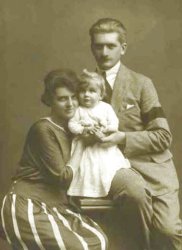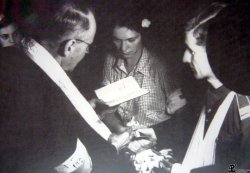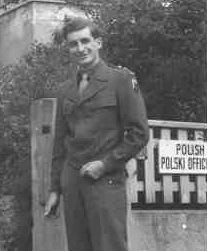This is the personal page of Bill (Bolesław) C. Biega
If you are interested in travel, sailing or reading about Poland - its history, or the wonderful cities and countryside,
you will surely enjoy the information collected by me during many years of
travel and sailing all over the world. Click on any of the links in the left-hand column and choose any subject you wish.
But first, I hope you would like to know a little more about me and my family.
Here is some family background:
Our family originated in southern Poland, (see map) in the upper valley of the river San. Our branch of the Biega family goes back to
Jan Biega, one of the sons of Josef Biega, who owned a small farm in the
village of Dębna, about 15 miles north of the ancient town of Sanok. Read the full story about the remarkable careers of three generations.
My father, Bolesław Biega, was studying international law at the Sorbonne University in Paris. There he met my mother, Marjorie Thomas, who was a member of the British delegation to the Versailles Peace Conference that ended World War I. He graduated and was given a position in the Polish Ministry of Foreign Affairs. They married in London in 1921 and returned to Warsaw
 I was born in Warsaw in 1922, in the flat of my Aunt Jadwiga on Three Crosses Square (Plac 3ch Krzyzy). Shortly afterwards, my father was assigned to the Polish Embassy in London as Second Secretary. Unfortunately, my mother died two years later. Subsequently my father remarried, another English woman, Baba Seely. I lived for several years with her parents in the village of Sutton-on-Sea on the North Sea coast, and went to school there. Then in 1934, after my father had returned to Warsaw, I joined him in Poland. I was enrolled in the Sułkowski school in Rydzyna, in western Poland. I had only one year left to graduation when Nazi armies invaded September 1, 1939.
I was born in Warsaw in 1922, in the flat of my Aunt Jadwiga on Three Crosses Square (Plac 3ch Krzyzy). Shortly afterwards, my father was assigned to the Polish Embassy in London as Second Secretary. Unfortunately, my mother died two years later. Subsequently my father remarried, another English woman, Baba Seely. I lived for several years with her parents in the village of Sutton-on-Sea on the North Sea coast, and went to school there. Then in 1934, after my father had returned to Warsaw, I joined him in Poland. I was enrolled in the Sułkowski school in Rydzyna, in western Poland. I had only one year left to graduation when Nazi armies invaded September 1, 1939.
The full story of my life under German occupation and the following years is covered in my book "Thirteen Is My Lucky Number". At this link you may read some excerpts. However I will continue with a brief outline.
As a member of the high school Cadet Training Corps, I marched east across Poland to avoid the onrushing German armies. On September 17 the Soviet armies invaded Poland and we marched back to within a 100 miles of Warsaw and participated in the last battle of the Polish army at Kock, which ended October 5.
 As the Germans had closed schools, I completed high-school in secret groups. Later the Germans allowed a school for technicians to open. University professors used this as the venue for conducting university courses. This way I completed my undergraduate courses in electrical engineering. Having also joined the Underground Home Army - A.K., at the same time I completed clandestine officer training. Upon graduation I was leader and instructor for several groups of five in the "Kilinski" group, preparing for the eventual uprising against the occupier.
As the Germans had closed schools, I completed high-school in secret groups. Later the Germans allowed a school for technicians to open. University professors used this as the venue for conducting university courses. This way I completed my undergraduate courses in electrical engineering. Having also joined the Underground Home Army - A.K., at the same time I completed clandestine officer training. Upon graduation I was leader and instructor for several groups of five in the "Kilinski" group, preparing for the eventual uprising against the occupier.
As the Soviet army was within a few miles of Warsaw in their westward advance against the Germans, the Uprising started August 1 1944. Stalin halted the Soviet advance, and refused to allow allied British and American planes to land on Soviet territory, thus virtually preventing any reinforcements or supplies from reaching the fighting Poles. Recent programs on CNN and the History channel, as well as Norman Davies' book "Rising '44" have well documented this betrayal of the Polish Underground by our allies. Nevertheless, the Polish Home Army continued its struggle against superior German forces for 63 days. During this time, although wounded, I also managed to wed my long time sweetheart, and Underground companion, Lili - the wedding was recorded by a film unit that was stationed across the street, and has been seen in many publications and tv shows.
 Upon the capitulation we both went into German prison camp, from which we emerged on the eve of the Allied victory in May, 1945. I then worked for over a year as Polish Liaison Officer to the U.S. Army. First helping evacuate Poles from Saxony prior to its takeover by the Soviets. Then I was assigned as liaison to the American occupation forces in south-western Germany, with my base in Esslingen. There our first son, Mark, was born in June 1946.
Upon the capitulation we both went into German prison camp, from which we emerged on the eve of the Allied victory in May, 1945. I then worked for over a year as Polish Liaison Officer to the U.S. Army. First helping evacuate Poles from Saxony prior to its takeover by the Soviets. Then I was assigned as liaison to the American occupation forces in south-western Germany, with my base in Esslingen. There our first son, Mark, was born in June 1946.
When the Allies withdrew recognition of the Polish Government in exile (based in England), we went to England. I was demobilized in 1947 and started working as a draughtsman for a small company manufacturing transformers. With the help of Bill Murray-Lawes we purchased a small house in Catford, East London. A year later I passed the British examinations for an electrical engineer, and I obtained a position as chief design engineer with a small company in London, located on the Strand. Our second son, Peter Wojciech was born in 1947. We wished to go to the U.S. where many of our friends had already gone from Displaced Persons camps in Germany. However the quota for U.S. immigration visas for Poles was already used up for many years into the future.
 In mid 1950 the U.S. Congress passed a bill providing 18,000 extra visas for members of the Polish armed forces in exile. At the end of December we were on our way on the liner "Queen Mary", our passage being paid by the British government.
In mid 1950 the U.S. Congress passed a bill providing 18,000 extra visas for members of the Polish armed forces in exile. At the end of December we were on our way on the liner "Queen Mary", our passage being paid by the British government.
To our surprise, there was another Biega - Jan Biega - on the ship. He was approximately our age and on his way to Florida.
After a single day stop-over in New York we continued by train to Detroit, where our sponsors lived. In those days the sponsors had to put up a bond to ensure that we would not require any public assistance!
Continue to Part 2, working in the U.S.A., travel all over the world.
For more family details, see my Family History page, and my
book "Thirteen Is My Lucky Number", which describes my experiences in the war years, in the Warsaw Uprising of 1944, in prison camp, and then as an emigrant to the United States (some excerpts are provided).
You may also see a selection of personal family photos and from recent journeys in bcbphotos.html.
Return to Top of page.
Return to Table of Contentsfor other History Essays.


 I was born in Warsaw in 1922, in the flat of my Aunt Jadwiga on Three Crosses Square (Plac 3ch Krzyzy). Shortly afterwards, my father was assigned to the Polish Embassy in London as Second Secretary. Unfortunately, my mother died two years later. Subsequently my father remarried, another English woman, Baba Seely. I lived for several years with her parents in the village of Sutton-on-Sea on the North Sea coast, and went to school there. Then in 1934, after my father had returned to Warsaw, I joined him in Poland. I was enrolled in the
I was born in Warsaw in 1922, in the flat of my Aunt Jadwiga on Three Crosses Square (Plac 3ch Krzyzy). Shortly afterwards, my father was assigned to the Polish Embassy in London as Second Secretary. Unfortunately, my mother died two years later. Subsequently my father remarried, another English woman, Baba Seely. I lived for several years with her parents in the village of Sutton-on-Sea on the North Sea coast, and went to school there. Then in 1934, after my father had returned to Warsaw, I joined him in Poland. I was enrolled in the  As the Germans had closed schools, I completed high-school in secret groups. Later the Germans allowed a school for technicians to open. University professors used this as the venue for conducting university courses. This way I completed my undergraduate courses in electrical engineering. Having also joined the Underground Home Army - A.K., at the same time I completed clandestine officer training. Upon graduation I was leader and instructor for several groups of five in the "Kilinski" group, preparing for the eventual uprising against the occupier.
As the Germans had closed schools, I completed high-school in secret groups. Later the Germans allowed a school for technicians to open. University professors used this as the venue for conducting university courses. This way I completed my undergraduate courses in electrical engineering. Having also joined the Underground Home Army - A.K., at the same time I completed clandestine officer training. Upon graduation I was leader and instructor for several groups of five in the "Kilinski" group, preparing for the eventual uprising against the occupier.

 In mid 1950 the U.S. Congress passed a bill providing 18,000 extra visas for members of the Polish armed forces in exile. At the end of December we were on our way on the liner "Queen Mary", our passage being paid by the British government.
In mid 1950 the U.S. Congress passed a bill providing 18,000 extra visas for members of the Polish armed forces in exile. At the end of December we were on our way on the liner "Queen Mary", our passage being paid by the British government.